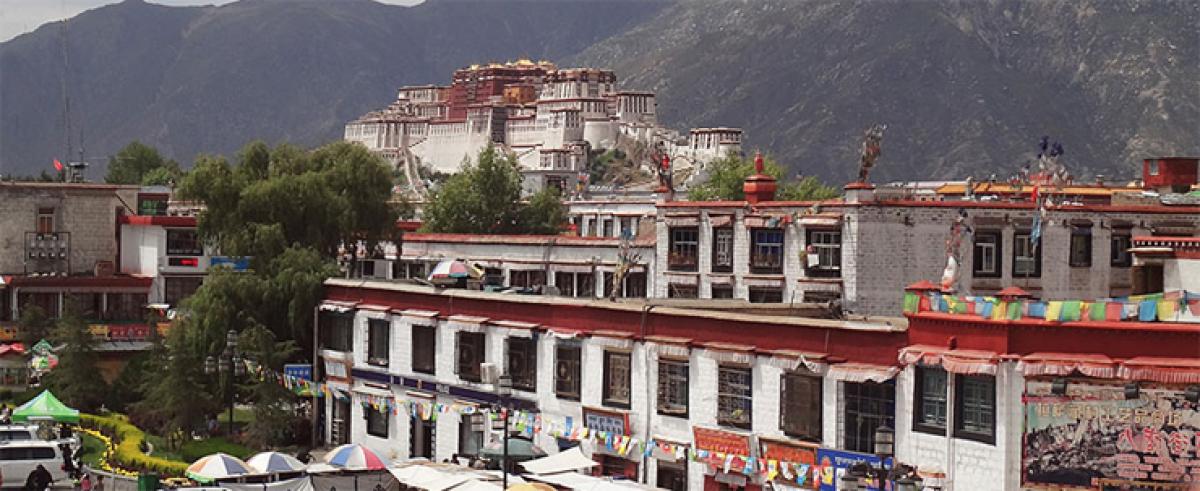Live
- Philippines orders full evacuation amid possible volcanic re-eruption
- Government Prioritizes Welfare of the Poor, says Dola Sri Bala Veeranjaneyaswamy
- Two Russian oil tankers with 29 on board damaged due to bad weather
- Telangana's Traditions Will Be Protected, Village by Village : BRS Leader MLC K. Kavitha
- Uganda to relocate 5,000 households from landslide-prone areas in eastern region
- Harish Rao Criticizes CM Revanth Reddy: "His Time is Over"
- Vijay Sethupathi Hails 'Vidudala-2' as a Theatrical Game-Changer
- Sahaj Yog: A Path to Inner Transformation and Harmony City takes giant strides
- Allu Arjun meets his uncle Nagababu at his residence
- J&K L-G felicitates Langar organisations & NGOs for contribution during Amarnath Yatra
Just In

x
Highlights
Lhasa, the heart of Tibetan culture, has been transformed into another \"Chinatown\", said Lobsang Sangay, the democratically elected leader of the Tibetan people-in-exile, as the people in Tibet fear Chinese settlers will overwhelm and reduce their ability to preserve their unique culture and identity.
Lhasa, the heart of Tibetan culture, has been transformed into another "Chinatown", said Lobsang Sangay, the democratically elected leader of the Tibetan people-in-exile, as the people in Tibet fear Chinese settlers will overwhelm and reduce their ability to preserve their unique culture and identity.

"The China State Council's announcement in 2014 to upgrade the status of the towns of Shigatse and Chamdo and in 2015 of Nyingtri to that of cities is of particular concern to Tibetans," the political successor of the Dalai Lama told this IANS correspondent, who was in Tibet earlier this month at the invitation of the Chinese government.
He said the city of Lhasa, famed for the hilltop 13-storied Potala Palace that was once the seat of the Dalai Lama, has seen an exponential urban expansion that has attracted migrant Chinese workers.
"The heart of Tibetan culture has been transformed into another Chinatown by this population shift where Tibetans live in small ghettos surrounded by an expanding urban China."
"We fear the same negative transformation will happen to Shigatse and Chamdo, immeasurably reducing the ability of the Tibetan people to preserve their culture and identity."
At the same time, Sangay, who completes four years in office on August 8, believes Tibetans equally fear that Chinese settlers will overwhelm and swamp rural and nomadic Tibet.
"Though Tibetans welcome economic development in the form of modernisation, their experience in the face of urbanisation is one of economic marginalisation, social exclusion and environmental destruction," he said.
Wu Yinggjie, the first deputy secretary of the Communist Party of China's Tibet Autonomous Region committee, told IANS that Tibet now presents a picture of mixing traditional and modern elements, featuring mainly economic, cultural prosperity and harmony.
"We have spent 27.37 billion yuan ($4.7 billion/Rs.300 billion) for providing affordable houses to 2.3 million people in Tibet. The per capital net income of the farmers and herdsmen in Tibet was 7,359 yaun in 2014," he said.
Countering Wu's claims, Sangay said the Chinese government has built major infrastructure but mainly concentrated in urban areas.
"It is also true that 90 percent of Chinese migrants work in urban areas. Hence, primary beneficiaries are the Chinese migrants. More than 300,000 nomadic herders have been resettled since the early 2000s," he said.
Sangay said in Lhasa the impact could be seen with the around 70 percent of private sector firms owned or run by the Chinese and more than 50 percent of government officials being the Chinese.
"Such blatant discrimination and economic marginalisation will only create more resentment among Tibetans."
Responding to the growing proximity between the two Asian giants, India and China, Sangay said: "India should consider recognising Tibet as a core issue because China publicly says Tibet is a core issue. There is no way around Tibet if India and China wants to solve the border issue and improve bilateral relationship."
On extensive mineral extraction, deforestation and construction of highways and railways in the name of development in Tibet, the 47-year-old Sangay said the Tibetan plateau is staring at ecological destruction.
"By China's own estimate, majority of pristine forests in Tibet have been destroyed especially on the side of the Indian border, causing floods. The Chinese have removed over $54 billion worth of timber from Tibet (1959-1985) and, due to mismanagement," he said.
But Sangay believes in dialogue over resolving the issue of Tibet.
"Fifty-six years of occupation, resentment and repression has to come to an end and replaced with dialogue. There should be dialogue between envoys of His Holiness the Dalai Lama and the representatives of the Chinese government if the Tibet issue is to be resolved peacefully."
"The middle-way approach is still our policy. Regarding the talks, our stand is still the same," he added.
China and the Dalai Lama's envoys have held nine rounds of talks since 2002 to resolve the Tibetan issue but no major breakthrough has been achieved so far.
The last talks were held in Beijing in January 2010.
Asked whether the people in exile will one day go back to their homeland, Sangay replied: "Absolutely. Freedom will be restored and His Holiness the Dalai Lama will return to Tibet sooner than later."
The Dalai Lama has lived in India since fleeing his homeland in 1959. The Tibetan administration-in-exile is based in this northern Indian hill town.

Next Story
More Stories
ADVERTISEMENT
© 2024 Hyderabad Media House Limited/The Hans India. All rights reserved. Powered by hocalwire.com







